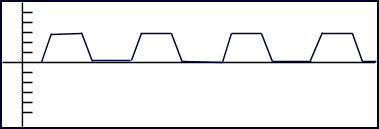Breathing isn’t just a matter of
inhaling the good air and exhaling the bad used air. The entire respiratory
pattern is important. Rate, depth, timing, and consistency of breaths are all
important to the delicate balance of respiration and metabolism.
Certain illnesses or injuries can
cause changes in the breathing pattern. Changes other than the typical fast or
slow breathing that is most common with many conditions. Below are some of the
less common breathing patterns that make many healthcare professionals ask
themselves… “Hey, what is that pattern anyway?”
|
Cheyen-Stokes:
- This breathing pattern is characterized by periods of
respirations during which the spontaneous tidal volume starts
shallow and progressively gets deeper with each breathe, then
gets progressively more shallow with each breathe. This is
followed by a period of apnea that can last anywhere from 15
seconds to 120 seconds. This cycle is repeated over and over.
- Causes: Cheyen-Stokes breathing is often caused by strokes,
traumatic brain injuries, brain tumors, carbon dioxide
poisoning, and metabolic encephalopathy. This pattern can also
be seen in healthy patients experiencing first-time high
altitude sickness, and can also be a normal side effect of IV
morphine administration.
|
|
Biot's Breathing (aka "Cluster" breathing):
- Biot's breathing is characterized by periods, or "clusters",
of fairly rapid respirations of close to equal depth followed by
reular periods of apnea that can last between 15 seconds to 120
seconds. Biot's breathing is very imilar to Cheyen-Stokes except
the spontaneous tidal volume is equal throughout the period of
respiration.
- Causes: Biot's breathing is usually caused by damage to the
medulla oblongata by stroke (CVA) or trauma, or pressure on the
medulla due to uncal or tenorial herniation. Biot's breathing
can also be caused by prolonged opioid abuse.
|
|
Kussmaul's Breathing:
- Labored hyperventilation characterized by a deep and rapid
respiratory pattern.
- Causes: This type of labored hyperventilation is usually
seen in the late stages of a severe metabolic acidosis. An
example would be an acute diabetic ketoacidosis (DKA). The
patient becomes "air hungry" and the desperate gasping
characteristic of Kussmaul's breathing almost appears
involuntary. Most of the time a respiratory pattern secondary to
a metabolic acidosis is rapid and shallow, and the true Kussmaul
breathing pattern is rarely seen because the acidosis is often
corrected before the patient reaches that stage of the
condition.
|
|
Apneustic Breathing:
- An apneustic breathing pattern has prolonged inspiratory
phases with each breathe, followed by a prolonged expiratory
phase that is often mistaken for an apneic period.
- Causes: Apneustic breathing is usually caused by damage to
the upper part of the pons, which is the uppermost section of
the brain stem. The pons contains, among other things, the
"respiratory center" of the brain.
|
|
Ataxic Breathing:
- A completely irregular breathing pattern with irregular
pauses and unpredictable periods of apnea. As breathing
continues to deteriorate ataxic breathing begins to merge with
agonal respirations.
- Ataxic breathing is usually cused by damage to the medulla
oblongata secondary to trauma or stroke. This respiratory
pattern indicates a very poor prognosis.
|
|
|
|

|
"Because at the Head of Every Team is a
Respiratory Therapist..."
|

